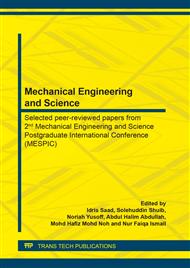[1]
C. Li, Y. Yuan, P. He, J. Yuan, H. Yu, Improved equivalent mass-spring model for seismic response analysis of two-dimensional soil strata, Soil Dyn. Earthq. Eng. 112 (2018) 198-202.
DOI: 10.1016/j.soildyn.2018.05.001
Google Scholar
[2]
M.N. Abdul Rani, H. Ouyang, M.A. Yunus, B.A. Aminudin, Model updating for a thin steel sheet welded structure, 20th International Congress on Sound & Vibration (2013).
Google Scholar
[3]
R.R. Craig Jr., A.J. Kurdila, Fundamentals of Structural Dynamics, second ed., John Wiley & Sons, (2011).
Google Scholar
[4]
D. Radomirovic, I. Kovacic, Deflection and potential energy of linear and nonlinear springs: approximate expressions in terms of generalized coordinates, Eur. J. Phys. 34(3) (2013) 537–546.
DOI: 10.1088/0143-0807/34/3/537
Google Scholar
[5]
E.M. Lui, Y. Liu, M. Oguzmert, Effects of diaphragm spacing and stiffness on the dynamic behavior of curved steel bridges, Steel Structures 6 (2006) 163-174.
Google Scholar
[6]
A. Bourdim, A. Meghdir, A. Bouizem, Numerical study on dynamic behavior of boring bar of unequal bending stiffness, Proceedings in Manufacturing Systems 7(2) (2012).
Google Scholar
[7]
J.A. Zakeri, V. Ghorbani, Investigation on dynamic behavior of railway track in transition zone, J. Mech. Sci. Technol. 25(2) (2011) 287-292.
DOI: 10.1007/s12206-010-1202-x
Google Scholar
[8]
R. Omar, M.N. Abdul Rani, W.I.I. Wan Iskandar Mirza, M.A. Yunus, M.H. Othman, Finite element modelling and updating for bolted lap joints, J. Mech. Eng. SI 4(3) (2017) 202-222.
DOI: 10.1088/1757-899x/506/1/012009
Google Scholar
[9]
K.C. Chang, C.W. Kim, Modal-parameter identification and vibration-based damage detection of a damaged steel truss bridge, Eng. Struct. 122 (2016) 156–173.
DOI: 10.1016/j.engstruct.2016.04.057
Google Scholar
[10]
X. Lei, B. Zhang, Analyses of dynamic behavior of track transition with finite elements, J. Vib. Control 17(11) (2010) 1733–1747.
DOI: 10.1177/1077546310385035
Google Scholar
[11]
A. Saxena, M. Chouksey, A. Parey, Effect of mesh stiffness of healthy and cracked gear tooth on modal and frequency response characteristics of geared rotor system, Mech. Mach. Theory 107 (2017) 261-273.
DOI: 10.1016/j.mechmachtheory.2016.10.006
Google Scholar
[12]
L.M. Khoo, P.R. Mantena, P. Jadhav, Structural damage assessment using vibration modal analysis, Struct. Health Monit. 3(2) (2004) 177-194.
DOI: 10.1177/1475921704042680
Google Scholar
[13]
J. Ahmad, S. Cheng, F. Ghrib, Effect of the number of cross-tie lines on the in-plane stiffness and modal behavior classification of orthogonal cable networks with multiple lines of transverse flexible cross-ties, J. Eng. Mech. 142(4) (2016) 1-13.
DOI: 10.1061/(asce)em.1943-7889.0001008
Google Scholar
[14]
T. Liu, A.W. Bargteil, J.F. O'Brien, L. Kavan, Fast simulation of mass-spring systems, Proceedings ACM Transactions on Graphics 32(6) (2013).
DOI: 10.1145/2508363.2508406
Google Scholar
[15]
K. Zhao, L. Cheng, S. Li, A. Liao, A new updating method for the damped mass-spring systems, Appl. Math. Model. 62 (2018) 119–133.
DOI: 10.1016/j.apm.2018.05.024
Google Scholar
[16]
W. Wan, Constructing a damped spring-mass system with prescribed mixed eigendata, Procedia Eng. 174 (2017) 1268-1275.
DOI: 10.1016/j.proeng.2017.01.301
Google Scholar
[17]
D. Zhou, T. Ji, Estimation of dynamic characteristics of a spring-mass-beam system, Shock Vib. 14 (2007) 271–282.
DOI: 10.1155/2007/127964
Google Scholar
[18]
A.A. Nikooyanz, A.A. Zadpoor, Mass-spring-damper modelling of the human body to study running and hopping - an overview, Proceedings of IMechE 225 Part H: J. Engineering in Medicine (2011).
DOI: 10.1177/0954411911424210
Google Scholar
[19]
D. Radomovic, I. Kovacic, Stiffness properties of certain oscillatory systems: quantification and possibilities for corrections, Eur. J. Phys. 36 (2015) 1-15.
DOI: 10.1088/0143-0807/36/3/035031
Google Scholar
[20]
A.D. Shaw, S.A. Neild, D.J. Wagg, P.M. Weaver, A. Carrella, A nonlinear spring mechanism incorporating a bistable composite plate for vibration isolation, J. Sound Vib. 332(24) (2013) 6265-6275.
DOI: 10.1016/j.jsv.2013.07.016
Google Scholar
[21]
B. Lakhlani, H. Yadav, Development and analysis of an experimental setup of spring - mass - damper system, Procedia Eng. 173 (2017) 1808-1815.
DOI: 10.1016/j.proeng.2016.12.223
Google Scholar
[22]
M.S.A. Sulaiman, M.A. Yunus, A.R. Bahari AR, M.N. Abdul Rani MN, Identification of damage based on frequency response function (frf) data, MATEC Web of Conferences 90(01025) (2017) 1-9.
DOI: 10.1051/matecconf/20179001025
Google Scholar
[23]
M.S. Mohd Zin, M.N. Abdul Rani, M.A. Yunus, W.I.I. Wan Iskandar Mirza, A.A. Mat Isa, Z. Mohamed, Modal and frf based updating methods for the investigation of the dynamic behaviour of a plate, J. Mech. Eng. 4(3) (2017) 175-189.
DOI: 10.1063/1.5032017
Google Scholar
[24]
Test certificate, 2013. Guangdong Guangyun Aluminium In-dustry Co. Ltd., China.
Google Scholar
[25]
J.W. Ringsberg, P. Ernholm, L. Hagström, Analysis of free vibration characteristics and mode shapes of a semi-submersible platform, Proceedings of the ASME 2011 30th International Conference on Ocean, Offshore and Arctic Engineering (2011).
DOI: 10.1115/omae2011-49088
Google Scholar


